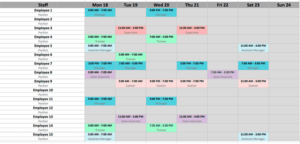
What is Performance-Based Scheduling
Performance-based scheduling is an ideal way to capitalize on the sales and operational strengths of your front line employees. It gives managers the tools to ensure their teams are scheduled at the right place and right time to drive optimum performance and allows them to make calculated scheduling decisions based on real-time business trends.
Instead of scheduling to preferences, or treating the scheduling process like an operational task, performance-based scheduling enables your team to think strategically about how they position their team for success in the week(s) ahead.
Making this shift helps you transition conversations around scheduling into more strategic discussions between you and your leaders. After all, we’re all here to drive performance and experience for our customers, and scheduling plays a big role in that.
Put Profit and Productivity at the Center of Your Approach Using Performance-Based Scheduling
There are three big problems with the way most schedules are created.
- Traditional tools make it hard to gain clear visibility throughout your organization.
- There’s rarely an alignment between business and labor trends.
- Employee performance isn’t visible during the scheduling process, preventing them from being positioned at the best times for business.
Store Managers tend to be the only individuals who know why they schedule their team the way they do. Whether they create a new schedule weekly or copy it week to week with slight adjustments, currently no specific data drives those changes.
For most managers, their scheduling tool might look a little like this:

For store managers and even senior managers like DMs and VPs, it’s nearly impossible to keep up to speed with location and employee specific performance trends. This process takes a lot of time and puts a lot of pressure on the scheduler when changes need to be made. What we found is businesses don’t have the time or tools to effectively schedule against business and employee trends while providing teams with the visibility they need to schedule.
Scheduling has become a mundane, check-the-box task which very rarely takes current business trends or employee performance into account ensuring the best decisions are being made for the business.
The solution? We need to make it easier for sales, profit and productivity to drive scheduling decisions.
Performance-based scheduling solves these problems by integrating location and employee level performance insights into the scheduling process, ensuring strengths are maximized and labor strategies are effective. It does all of this while creating a single source of truth and one point of control for schedule makers.
5 Things You Need to Make Performance-based Scheduling Happen
1. Store Specific Sales Forecasting and Trend Data
A retailer needs accurate daily and hourly, sales forecasting from as many years of historical sales and profit data available (obtained from a POS system). You also need recent trend data to take into account weather patterns, recent sales spike and yes, even things like COVID-19. This all must be calculated in near real-time processing for company KPI alignment and is best supported by machine learning or AI technology for timely accuracy.
2. Individual Sales Data
You must obtain individual sales data which tracks your sales employees time clock, previous schedules and profitability by employee. It’s also helpful to know the tenure of the employee and data to analyze ramp time and effectiveness. Understanding this data lets you know where each employee and team thrives the most. You gain visibility into which reps crush it during busy times and which ones struggle. Onboarding new reps can also be optimized since you know who the heavy hitters are that will get them up to speed the quickest.
3. Store Location Data, Employees and Management
Assuming you are a multi-store chain, you need all store location data, employees store assignment and management. This will ensure you have the proper staffing coverage and assignments.
4. Real-time Reporting – Store Level and C-Suite
Retailers need real-time reporting and visibility so VPs and DMs can understand KPI effectiveness of their region and districts. Store managers need reporting and easy to use visuals to make real-time decisions and the store employees can get real-time updates on their schedules, preferably via a mobile app.
C-level executives and owners need to understand how labor is being optimized throughout the retail enterprise to drive revenue, profitability and NPS. This gets team buy-in at all levels.
5. The Right Technology
Finally you need to be able to build out this process all together in a simple format. Today many organizations manage scheduling through spreadsheets, calendars and base shifts off of the employees requests. Through the advancement of AI technology, new performance-based software solutions can assist to align POS with scheduling to deliver a simplified process which makes scheduling strategic to your retail business.
4 Key Benefits of Performance-Based Scheduling
We’ve covered a handful of benefits you can expect when using performance-based scheduling. Here are four more to consider as you bring your labor strategy to life:
1. Optimize employee schedules to support business trends
With performance-based scheduling, you are able to schedule the right person, for the right shift, at the right time. You prevent the common occurrence of over-scheduling on slow days and under-scheduling on busy days.What if your business was ideally staffed 100% of the time? Sounds almost too good to be true, but with the right tools this can become a reality in your business.
2. Analyze performance data in real time without spreadsheets
Quit the guesswork and remove complacency with your scheduling. Spreadsheets don’t capture and match past performance to help guide future needs. They also limit the amount of information leaders see and prevent complete transparency. Through key integrations with POS systems and AI technology, performance-based scheduling helps you stop repeating the wrong things and start making decisions on real data.
3. Identify top performers and ensure they’re scheduled during prime shifts
With access to actionable data, it is easy to identify top performers and the scenarios where they perform at their best. Duly, poor performers can be identified and scheduled during slower times or be put on a performance review plan.
4. Have data to support proactive, strategic conversations
It’s all too common that labor conversations are happening way too late to drive action. Without the right tools and reporting, it is challenging to bring this into your leadership’s weekly routine. Bring clarity into scheduling processes for your organization in real-time, so you and your leaders can help guarantee success.
Performance Based Scheduling FAQ
Here are the most common questions we get regarding performance-based scheduling:
What makes performance-based scheduling successful?
Having buy-in from the entire team and the right technology in place is crucial in making implementation a success. Communication is key to ensuring everyone understands the new process and expectations. The team needs to understand what will occur when expectations are met or missed. Transparency is your best friend when it comes to introducing new processes for your team and your business will gladly reap the benefits.
Does performance-based scheduling reduce turnover?
Yes, especially if you have the right tools. When you’re able to translate scheduling decisions to the monetary opportunities for commission, sales reps start to understand the opportunities that they’re missing, or the personal time that they’re gaining back while the store is slow. Data helps to present this and helps you build a stronger, more loyal team.
What KPIs can you measure with performance-based scheduling?
A variety of KPIs (Key performance indicators) can be measured when performance-based scheduling is being used. It’s important to know what you want to track and have the technology in place to appropriately measure it. Commonly tracked KPIs include sales per employee, average transaction per employee, customer conversion rates, and NPS. Measuring these can help motivate your team and make sure you have a clear picture of how your business is performing.
How do I create a retail employee schedule?
Check out our retail scheduling and best practices guide for a step-by-step approach to creating effective retail schedules.
Notifications



